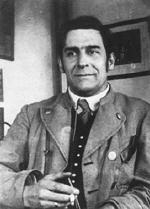
Franz Marc was born in Munich, Bavaria. His father, an artist, encouraged him to study art, but Marc studied theology and philosophy before entering the Munich Art Academy in 1900. Marc was a moody young man and had difficulty finding a way to express himself. During his first trip to Paris in 1903, he had his first contacts with the Impressionists, and was particularly impressed with the work of Henri Rousseau. In the following year, contact with the avant-garde "Jugendstil" group in Munich helped him to clarify his own ideas. When he made a second trip to Paris in 1907, he saw the work of van Gogh.
In 1910 he met Macke and Kandinsky, became a member of the "Blaue Reiter" group, worked on their first almanac, and participated in the first Blaue Reiter exhibit in Germany. Marc, who wrote that "matter is something which the human mind suffers, at best, but does not recognize," began to develop his own form of expression in 1912 as the result of a meeting with Delaunay. In his effort to paint the spiritual side of nature, just as Kandinsky sought to paint the spiritual nature of man, Marc painted animals. Within a year he was painting landscapes and was well on the road to abstraction, but whether he would have continued on this path is, again, a matter of conjecture. Marc's career ended abruptly on the battlefield of Verdun in 1916. Our only knowledge of the last two years of his life has come from his notebook, found beside him and filled with nonobjective drawings depicting a world of horror.